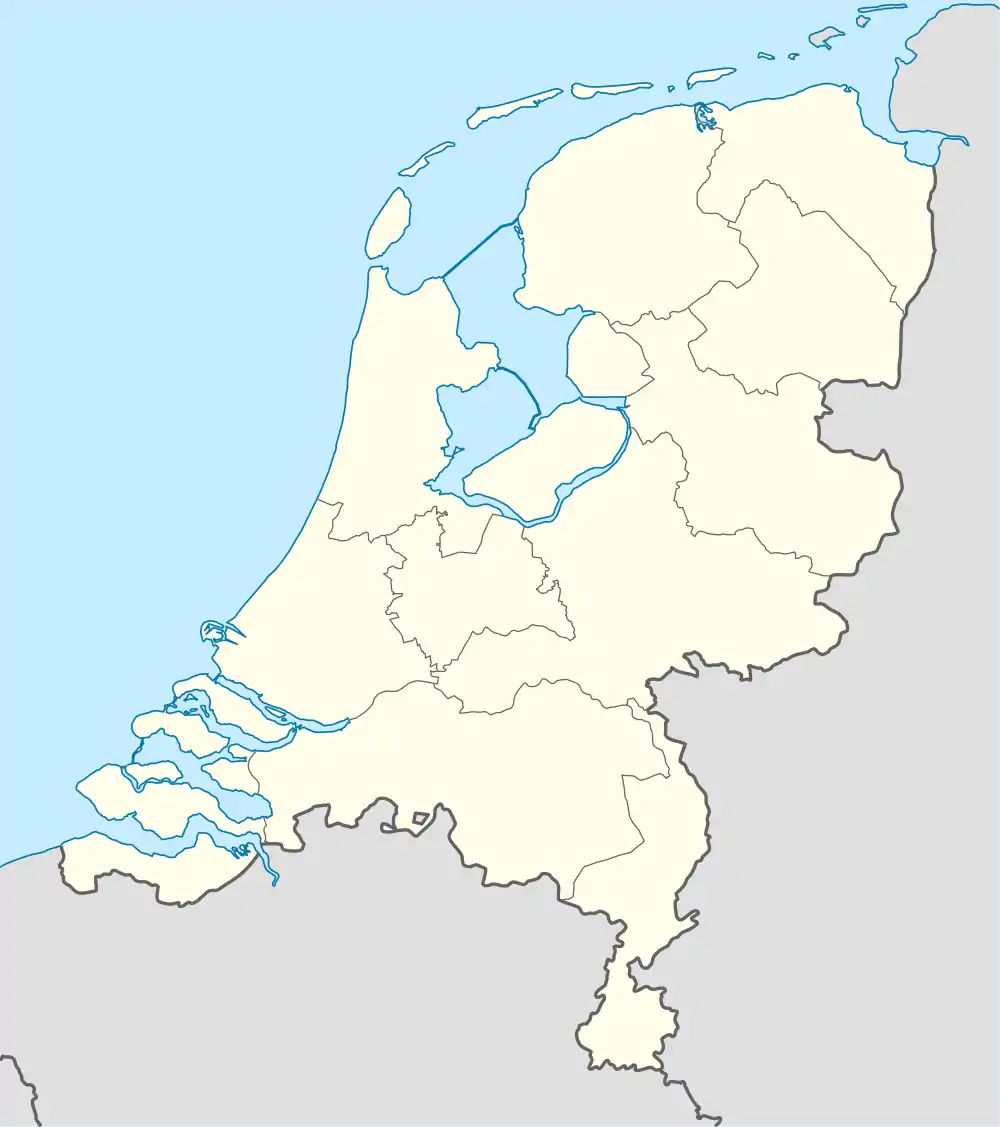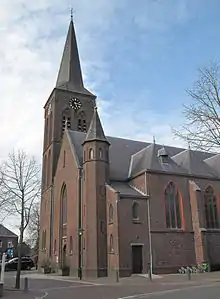Meterik
Meterik (Limburgish: De Miëterik) is a village in the Dutch province of Limburg. It is located in the municipality of Horst aan de Maas, bordering rich farmland to the north and a moor called De Peel to the west. Meterik is located along a brook, the Kabroekse beek, which provides fertile grazing lands.
Meterik | |
|---|---|
Village | |
 Meterik | |
| Coordinates: 51°27′18.9″N 6°1′29.7″E | |
| Country | Netherlands |
| Province | Limburg |
| Municipality | Horst aan de Maas |
| Population (2019) | 1,627 |
On 1 January 2019, Meterik had 1627 inhabitants. Meterik is the ancestral home of astronomer Peter Jenniskens. The village is known as a haven for temporary workers for seasonal work in the agricultural sector. Currently many of the workers are from Bulgaria and Romania.
History
The area has been inhabited since prehistoric times. After the Weichselian glaciation, hunter gatherers of the mesolithic (10,000-5,300 BC) frequented the heathlands based on stone tools found. Slash and burn farming came to the region at the start of the neolithic around 5500 BC, with Aegean Neolithic Farmers of the Bandkeramic (linear pottery) culture. Around 2900, the Bronze Age and increased mobility from the domestication of the horse brought farmers of the Corded Ware culture and the proto-indo European language to the area. Languages evolved from Northwestblock (Hilversum culture 1850-1650 BC), Italo/Celtic (Tumulus culture 1600-1200 BC) and proto Celtic (Urnfield culture 1300-750 BC) cultures of the Bronze Age. The Iron Age arrived with farmers of the proto Celtic Hallstatt culture (800-450 BC) and Celtic La Tène culture (450-50 BC). In 1983, parts of the grating and the coupola of a pottery oven were found along the St. Maartensweg in Schadijk and dated to about 500 BC.[1] Traces of Iron Age pottery from a nearby settlement were found along the Crommentuynstraat. [2][3] And the outline of a farm from the late Iron Age was discovered in Meterik's Field in 2006. [4] The region was part of the Roman empire (50 BC - 456 AD), with the influx of yet other people. After 515 AD, the area was part of Frankish Austrasia, the Carolingian empire and the Holy Roman Empire. A Carolingian settlement was found in the Meterik's Field with the floor plans of 23 large and 21 small buildings and four wells dated to 625-1000 AD.[5]
Meterik originated from scattered farms surrounding the open field created by these settlements, as have the communities of Schadijk (Limburgish: De Schaak) to the north, and Middelijk (Limburgish: Middelik) and Veld-Oostenrijk (Limburgish: Osterik) in the east. In the Middle Ages (after 1100 AD) the area became part of the County of Guelders. A feudal system of agriculture developed, with farming areas and moving farms in the service of lords, which later developed into the communities recognized now surrounding the open field. Peat from the moor was used to fertilize the land, raising its elevation by several meters over time. Initial power centers were along the river Maas. In 1326, the nearby castle Huys Ter Horst was founded at the confluence of Kabroekse Beek and Groote Molenbeek, but rights to the lands moved hands. At one point the northern part of the field near Schadijk was in hands of the Van Mirlaer family (Meerlo, near the confluence of the Groote Molenbeek and river Maas), while the southern and eastern parts were in hands of the owners of the Huys Ter Horst castle. The oldest reference to Meterik for the area dates to 1483. In the Middle Ages, Meterik had its own defensive structure, called a "schans", about 0.5 hectares large and consisting of an earthen wall and a flooded ditch with a draw bridge. It was probably located near the brook. In 1622, the area is mentioned as the "schansweide". In 1755, a small house was located there, but taken down in 1793 prior to the oldest known map of the area being drawn, the Tranchot und v. Mueffling map of 1803–1813. [6]
Only in the 19th century, with political changes after the French conquest in 1794 and foundation of the United Kingdom of the Netherlands,[7] did the feudal system of moving farms settle into a number of family-owned farms. Those family names are still transmitted to later generations in the form of an informal Limburgish name that many locals use.[8] The invention of artificial fertilizer subsequently led to the agricultural development of the heathlands surrounding the field. Meterik became a nucleated village at the end of the 19th century, when local farmers obtained permission to establish a church under the condition that they themselves provided income for the priest. Subsequently, a church was established, a house for the priest, and a windmill was brought to the village to generate income for the priest.[9] A school was added in 1911 and monastery "St. Theresia" in 1925.
Church

The Church of Meterik, the Saint John the Evangelist, was built in 1899 designed by the architect Caspar Roermond Franssen. The first priest arrived in 1904. In 1922 his son Joseph Franssen enlarged the design of the Church, as the early chapel had become too small. After having been damaged during World War 2, the current church was built in 1946.
Parish
The Polish, who have settled in large numbers in North Limburg and North Brabant, have their own parish since 2006. It is a so-called categorical parish, which is not bound to a region, but to a group of people. The Polish parish has a Polish priest.
External links
- (in Dutch) History of Meterik's Field
- (in Dutch) Website Village Council Meterik
- (in Dutch) Website Windmill in Meterik
- (in Dutch) Website Huys Ter Horst
References
- W. J. H. Willems Archeologische kroniek van Limburg over 1984, PSHAL 121, 1985, p. 163-164
- N. Huisman Meterik, Crommentuynstraat (gemeente Horst aan de Maas). Een archeologische opgraving, ADC ArechoProjecten Rapport 2571, 2011, 23 pp
- J. Ras Archeologisch bureauonderzoek en inventariserend veldonderzoek door middel van grondboringen: Crommentuynstraat, Meterik, Gemeente Horst aan de Maas, ADC ArcheoProjecten Rapport 2236, 2009, 35 pp
- J. de Koning Een vroegmiddeleeuwse nederzetting op het Meterikse veld (630 tot ca. 1000 na Chr.). Definitieve opgraving te Horst a/d Maas (L), Meterik, Hollandia Archeologen, Hollandia, Zaandijk, 2009, 258 pp.
- J. de Koning Een vroegmiddeleeuwse nederzetting op het Meterikse veld (630 tot ca. 1000 na Chr.). Definitieve opgraving te Horst a/d Maas (L), Meterik, Hollandia Archeologen, Hollandia, Zaandijk, 2009, 258 pp.
- M. Stiekema, 2012. Archeologisch bureauonderzoek en booronderzoek St. Jansstraat 20-22 te Meterik in de gemeente Horst aan de Maas. Econsultancy Rapport number 10061473 HOR.BRO.ARC
- H. Knippenberg The incorporation of Limburg in the Dutch state, Dordrecht: Springer, 1999, p. 39-60. https://doi.org/10.1007/978-94-011-4293-9_3
- J. M. R. Voesten Tgene Spijker, geschiedenis van 'te Vousten' aan de Meterik, 1400-1800, 2015, 652 pp.
- S. Jenniskens Geschiedenis van de kerk te Meterik, 1982, 36 pp.
